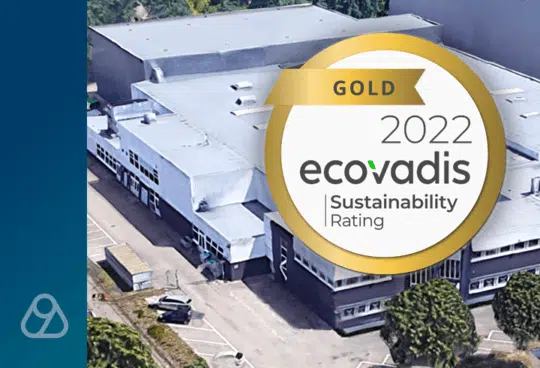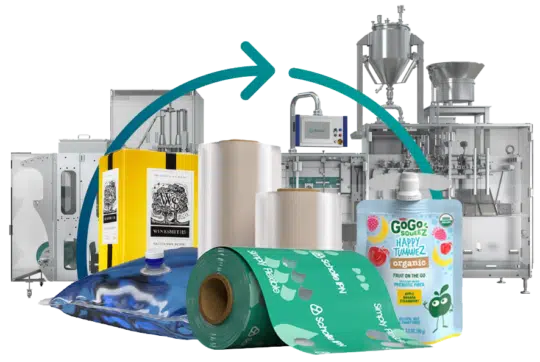What Does Source Reduction Look Like at Scholle IPN?
April 19, 2022
Sustainability is a bucket term for a lot of different ideas and actions. You’ve likely heard many of these words when companies talk about sustainability: recycling, the circular economy, carbon footprint…it can be hard to keep track of everything.
We employ all the tactics listed above, but there’s a concept we at Scholle IPN implement daily that doesn’t get quite enough attention: source reduction. Let’s break down what source reduction is and how Scholle IPN puts ideas into action.
Sustainability & Source Reduction
The Environmental Protection Agency (EPA) defines sustainability as “the ability to maintain or improve standards of living without damaging or depleting natural resources for present and future generations.” The EPA even coined a phrase to help people employ sustainable practices in their everyday life that you’ve undoubtedly heard before: “Reduce. Reuse. Recycle.”
However, there’s a secret behind that common phrase—it’s not just a list of sustainable actions but items presented in order from most to least impactful. When possible, we should be engaging in acts that reduce the amount of natural resources we extract from the environment. That’s what source reduction is.
Let’s try an example. Plastic water bottles are a massive source of waste: around 1.5 million plastic bottles are sold each minute, and about 70% of those bottles are thrown away in landfills.
If you buy a plastic water bottle, you probably know that you should try to recycle it. However, it’s more impactful if the water bottle was never made at all, made with fewer resources, or made in a larger format to reduce the amount of raw materials needed.
At Scholle IPN, we’ve tackled water packaging with a source reduction mindset. We developed a flexible packaging film called 2Pure™ that helps brands easily switch from water bottles to bag-in-box for their water. We launched the first APR-recognized, 100% recyclable bag-in-box package for water in 2021 and helped brands like AJEPER and Aquasplash Limited switch from bottles to bag-in-box.
The results speak for themselves. Bag-in-box generates up to 66% less post-consumer waste, up to 36% fewer greenhouse gasses, and requires up to 69% less energy to produce than plastic bottles.
With a source reduction approach, we were able to meaningfully reduce the amount of materials used to package water without relying on measures like recycling, which often charges the end-user with the responsibility of making an environmentally conscious choice. We recognize our role in building a sustainable future and take actionable steps toward protecting the environment.
Reducing Materials, Transportation Costs & Waste
We looked at water packaging as an example of source reduction, but you could take anything from the Scholle IPN product line and see source reduction in action.
Scholle IPN is built around bag-in-box and pouch packaging. Flexible packaging can reduce greenhouse gas emissions by over 90%, and we break down how bag-in-box or pouches compare to other common packaging formats like PET and glass bottles. In most scenarios, products made with flexible packaging come out as more environmentally sustainable.
However, we don’t just stop at materials. Bag-in-box and pouch packaging formats are made with films that require fewer raw materials, but they also consume fewer resources as they travel through the supply chain. For example, bag-in-box is easily palletized, meaning it can be efficiently loaded and transported onto trucks, which means more materials can be delivered with fewer trips.
Then there’s waste. Even if we took all these measures to reduce the amount of raw materials we use, none of it would matter if the product arrives broken or spoils over time. This is where fitments come into play.
We already approach designing fitments with a source reduction mindset. For example, one of our newest designs, the Amerigo, uses less plastic and cuts 41.8% of the fitment’s original weight.
But fitments are also crucial in helping consumers waste less. Fitments protect from contaminants like oxygen, create a one-way delivery system for products, and ensure optimal evacuation—we’ve all tried scraping up the last of something, like the sour cream in a plastic tub or the ketchup in a bottle. Fitments help consumers use all of a product and do more with less.
Beyond the Product Line
Source reduction is a powerful manufacturing principle, but we also think about source reduction in our internal processes. We don’t just look at what we make but how we make it.
 We’re always looking for ways to use less on-site and recognize that we might not always have all the answers. We work with environmental assessment tools like EcoVadis and ISO 13485 certification programs to audit our work and give us tips for improvement.
We’re always looking for ways to use less on-site and recognize that we might not always have all the answers. We work with environmental assessment tools like EcoVadis and ISO 13485 certification programs to audit our work and give us tips for improvement.
But sometimes, solutions come from within. Recently, our plant in Suzhou, China, identified a water cooling system for our thermoregulators as a source of waste. The thermoregulators require a constant source of cool water to remain cold, so the team designed a closed-loop water pump that would continuously use the same water.
Source reduction also means investing in renewable energy. Our plants in China and Australia worked together to install hundreds of solar panels on their roofs. Within a year, the Australia branch kept 372.64 tons of CO2 from entering the atmosphere—the equivalent of driving a car 2,484,227 kilometers. In China, that number was almost tripled: they prevented 973 tons of carbon dioxide from entering the atmosphere.
Starting with Source Reduction
Every action towards building a sustainable future matters. No step is too small, but perhaps you’re at a point where you’re ready to do more.
 Sustainability starts with source reduction. Every action or process can be examined with a source reduction mindset, and that’s how we approach our work at Scholle IPN.
Sustainability starts with source reduction. Every action or process can be examined with a source reduction mindset, and that’s how we approach our work at Scholle IPN.
Source reduction informs every decision we make: from providing total packaging solutions so brands can have complete ownership over their packaging (and reduce the amount of waste working with dozens of suppliers can generate) to making films and fitments with fewer resources, we make sure our products are produced responsibly.
That means going back to the EPA’s original adage. “Reduce. Reuse. Recycle.” We hope it’s clear how important it is to focus on source reduction—we can answer any questions and figure out how you can incorporate packaging with a source reduction in mind. Contact Scholle IPN today.
